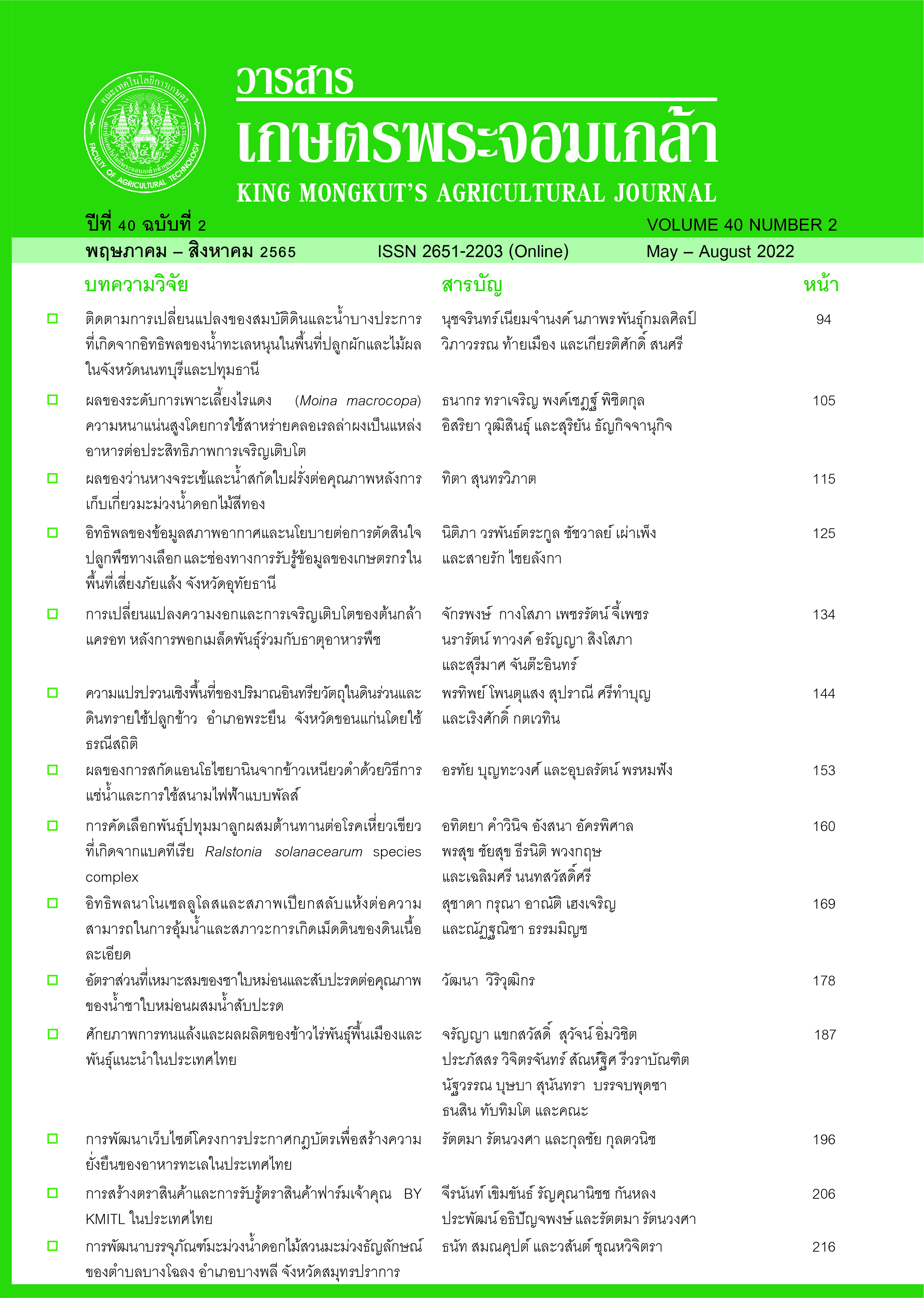การคัดเลือกพันธุ์ปทุมมาลูกผสมต้านทานต่อโรคเหี่ยวเขียวที่เกิดจากแบคทีเรีย Ralstonia solanacearum species complex English
Main Article Content
บทคัดย่อ
การทดสอบการเกิดโรคในปทุมมาลูกผสม กับเชื้อแบคทีเรีย Ralstonia solanacearum species complex สาเหตุโรคเหี่ยวเขียวทั้ง 9 ไอโซเลต พบ 1 ไอโซเลตที่สามารถเข้าทำลายและทำให้ปทุมมาเกิดโรคได้ คือ R. solanacearum ไอโซเลต Si16 biovar 4, phylotype I, sequevar 30 ซึ่งแยกจากปทุมมาที่มีลักษณะอาการเหี่ยวเขียว จากอำเภอสันทราย จังหวัดเชียงใหม่ เมื่อคัดเลือกปทุมมาพันธุ์ลูกผสมโดยทดสอบความต้านทานต่อโรคเหี่ยวเขียว พบว่าพันธุ์ที่มีความต้านทานสูงสุดและแสดงความรุนแรงของการเกิดโรคเหี่ยวเขียวที่ 0 เปอร์เซ็นต์ คือ พันธุ์ยูกิ พลอยทักษิณ แม่โจ้อิมเพลส 01 และแม่โจ้อิมเพลส 02 ส่วนพันธุ์ชมพูมะลิ ชมพูเส้น และลัดดาวัลย์ แสดงความต้านทานต่อโรค โดยแสดงความรุนแรงของโรคหลังปลูกเชื้อที่ 25, 10 และ 5 เปอร์เซ็นต์ตามลำดับ ส่วนพันธุ์ขาวมะลิเชียงราย เชียงใหม่พิงค์ และบิ๊กเรด แสดงความอ่อนแอสูงสุด โดยแสดงความรุนแรงของโรคที่ 100 เปอร์เซ็นต์ ซึ่งงานวิจัยนี้แสดงให้เห็นว่า พันธุ์ปทุมมาที่มีความต้านทานและต้านทานสูงสุด ต่อเชื้อแบคทีเรียสาเหตุโรคเหี่ยวเขียวสายพันธุ์ biovar 4, phylotype I, sequevar 30 คือพันธุ์ชมพูมะลิ ชมพูเส้น ลัดดาวัลย์ ยูกิ พลอยทักษิณ แม่โจ้อิมเพลส 01 และแม่โจ้อิมเพลส 02 ซึ่งความรู้ที่ได้จากงานวิจัยนี้สามารถใช้เป็นแนวทางในการคัดเลือกปทุมมาพันธุ์ลูกผสม เพื่อปลูกในเชิงการค้า และเพิ่มมูลค่าทางเศรษฐกิจในอนาคต
Article Details

อนุญาตภายใต้เงื่อนไข Creative Commons Attribution-NonCommercial-NoDerivatives 4.0 International License.
วารสารเกษตรพระจอมเกล้า
เอกสารอ้างอิง
ปิยะรัตน์ ธรรมกิจวัฒน์, นิพนธ์ ทวีชัย, อำไพวรรณ ภราดร์นุวัฒน์, สุรวิช วรรณไกรโรจน์ และสุรางค์ สุธิราวุธ. 2542. โรคหัวเน่าจากแบคทีเรียของปทุมมาและการตรวจเชื้อที่ติดมากับหัวพันธุ์. ใน การประชุมวิชาการของมหาวิทยาลัยเกษตรศาสตร์ ครั้งที่ 37 สาขาพืช สาขาส่งเสริม นิเทศศาสตร์. น. 295-302. มหาวิทยาลัยเกษตรศาสตร์; กระทรวงการเกษตรและสหกรณ์; กระทรวงวิทยาศาสตร์ เทคโนโลยีและสิ่งแวดล้อม; ทบวงมหาวิยาลัย, กรุงเทพฯ.
สุรชาติ คูอารัยยกุล. 2539. โรคเหี่ยวหรือหัวเน่าของไม้ดอกตระกูลกระเจียวและการป้องกันกำจัด. ใน เอกสารประกอบคำบรรยายการสัมมนาวิชาการ เรื่อง “ผลกระทบของโรคหัวเน่าของปทุมมาต่อการผลิตและการส่งออก. น.1-22. สำนักวิจัยและพัฒนาการเกษตรเขต 1 กรมวิชาการเกษตร กระทรวงเกษตรและสหกรณ์, กรุงเทพฯ.
สุรพล สว่างเนตร. 2548. การศึกษาแนวทางการแก้ไขปัญหาในการส่งออกหัวพันธุ์ปทุมมาไปต่างประเทศ. ใน ผลงานฉบับเต็ม กลุ่มวินิจฉัยศัตรูพืช ส่วนควบคุมพืชและวัสดุทางการเกษตร. น. 2-52. กรมวิชาการเกษตร, กรุงเทพฯ.
สุภาพร สัมโย และอำนวย อรรถลังรอง. 2563. สถานการณ์การผลิตปทุมมา (มิถุนายน 2563). สถาบันวิจัยพืชสวน กรมวิชาการเกษตร. หน้า 1-6.
https://www.doa.go.th/hort/wp-content/uploads/2020/10/สถานการณ์ปทุมมามิถุนายน2563.pdf (30 ธันวาคม 2564).
เสรี พิศิลป์. 2543. การตรวจสอบและคัดเลือกมะเขือเทศลูกผสมพันธุ์ต้านทานต่อโรคเหี่ยวเขียว. น.1-103. วิทยานิพนธ์ ปริญญาวิทยาศาสตรมหาบัณฑิต สาขาวิชาพืชสวน มหาวิทยาลัยขอนแก่น.
Alvarez, B., Lopez, M., and Biosca, G. 2008. Survival strategies and pathogenicity of Ralstonia solanacearum phylotype II subjected to prolonged starvation in environmental water microcosms. Microbiology 154: 3590-3598.
Ailloud, F., Lowe, T., Cellier, G., Roche, D., Allen, C., and Prior, P. 2015. Comparative genomic analysis of Ralstonia solanacearum reveals candidate genes of host specificity. BMC Genomics 16(270): 1-11.
Akarapisan, A., Kumvinit, A., Thungrabeab, M., Thumdee, S., and Kositratana, W. 2021. Phylotype, sequevar and pathogenicity of Ralstonia solanaceaum species complex from Northern Thailand. Journal of Phytopathology 170: 176-184.
Charkowski, A., Sharma, K., Parker, L. M., Secor, A.G, and John, E. 2020. The potato crop. In: Bacterial diseases of potato, pp. 351-388.
Dhital, P. S., Thaveechai, N., and Shrestha, K. S. 2000. Characteristic of Ralstonia solanacearum strains of potato wilt disease from Nepal and Thailand. Nepal Agriculture Research Journal 4: 42-47.
Fegan, M., and Prior, P. 2005. Bacterial wilt disease and the Ralstonia solanacearum species complex. In: How complex is the Ralstonia solanacearum species complex, pp. 449-462.
Hayward, A. C. 1994. “The host of Pseudomonas solanacearum” in Bacterial Wilt: The disease and its Causative Agent, Pseudomonas solanacearum, eds Harward AC and Hartman (Wallingford: CAB International). 9-24.
Horita, M., and Sakai, K. Y. 2020. Specific detection and quantification of Ralstonia pseudosolanacearum race 4 strains from Zingiberaceae plant cultivation soil by MPN-PCR. Journal of General Plant Pathology 86: 393-400.
Huang, Q., Yan, X., and Wang, F. J. 2012. Improved biovar test for Ralstonia solanacearum. Journal of Microbiological Methods 88: 271-274.
Khan, M., Rafi, A., Abbas, A., Ali, T., and Hassan, A. 2015. Assessment of yield losses caused by bacterial blight of rice in upper dir, Khyber Pakhtunkhwa province. Asian Journal of Agriculture and Biology 3(2): 74-78.
Kyaw, W. W. H., Tsuchiya, K., Matsumoto, M., Iiyama, K., Aye, S. S., Zaw, M., Kurose, D., Horita, M., and Furuya, N. 2017. Genetic diversity of Ralstonia solanacearum strains causing bacterial wilt of Solanaceous crops in Myanmar. Journal of General Plant Pathology 83: 216-225.
Piyarat, T., Nophone, T., Wichai, K., Julapark, C., Frederick, D.R., and Schaad, W. N. 2001. Genetic analysis of Ralstonia solanacearum strains from different hosts in Thailand using PCR-restriction fragment length polymorphism. Kasetsart Journal 35: 397-408.
Safni, I., Cleenwerck, I., Vos, D. P., Fegan, M., Sly, L., and Kappler, U. 2014. Polyphasic taxonomic revision of the Ralstonia solanacearum species complex: proposal to emend the descriptions of Ralstonia solanacearum and Ralstonia syzygii and reclassify current R. syzygii strains as Ralstonia syzygii subsp. syzygii subsp. nov., R. solanacearum phylotype IV strains as Ralstonia syzygii subsp. indonesiensis subsp. nov., banana blood disease bacterium strains as Ralstonia syzygii subsp. celebesensis subsp. nov. and R. solanacearum phylotype I and III strains as Ralstonia pseudosolanacearum sp. nov. International Journal of Systematic and Evolutionary Microbiology 64: 3087-3103.
Safni, I., Subandiyah, S., and Tegan, M. 2018. Ecology, epidemiology and disease management of Ralstonia syzygii in Indonesia. Frotiers in microbiology. 9: article 419.
Santana, B. G., Lopes, C. A., Alvarez, E., Barreto, C. C., Allen, C., and Quirino, B. F. 2012. Diversity of Brazilian biovar 2 strains of Ralstonia solanacearum. Journal of General Plant Pathology 78: 190-200.
She, X., Yu, L., Lan, G., Tang, Y., and He, Z. 2017. Identification and genetic characterization of Ralstonia solanacearum species complex isolates from Cucurbita maxima in China. Frontiers in Plant Science 1794(8): 1-11.
Thano, P., and Akarapisan, A. 2018. Phylotype and sequevar of Ralstonia solanacearum which causes bacterial wilt in Curcuma alismatifolia Gagnep. Letters in Applied Microbiology 66: 384-393.
Xu, J., Pan, Z. C., Prioi, P., Xu, J. S., Zhang, Z., Zhang, H., Zhang, L. Q., He, L. Y., and Feng, J. 2009. Genetic diversity of Ralstonia solanacearum strains from China. European Journal of Plant Pathology 125: 641-653.
Yang, W., Xu, Q., Liu, X. H., Wang, P. Y., Wang, M. Y., Yang, T. H., and Guo, H. J. 2012. Evaluation of biological control agents against Ralstonia wilt on ginger. Biological control 62: 144-151.


